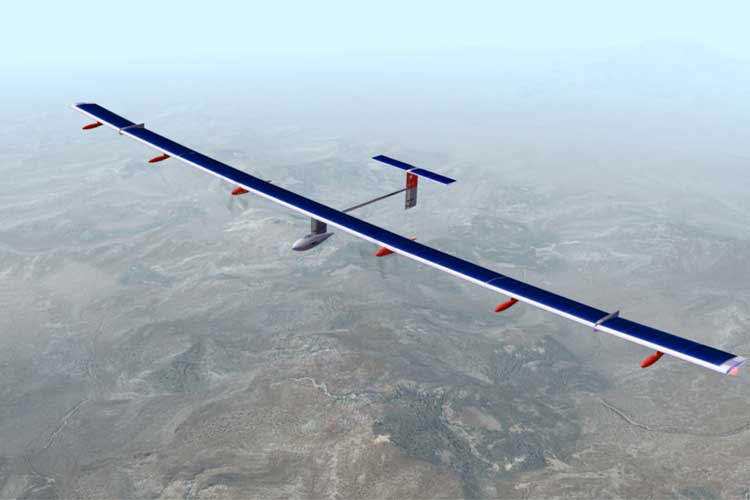El gran viaje del Solar Impulse 2 ha abierto el debate acerca de las energías renovables. Y Mauricio Osses señala que precisamente ese es el objetivo fundamental de toda esta hazaña científica y de ingeniería. “Con esto se quiere demostrar la capacidad de las energías renovables, incluso en actividades extremas como dar la vuelta al mundo con un avión solar”, señala. De esta manera, el académico descarta que esta iniciativa represente el nacimiento de un mercado para la industria aeronáutica propulsada por la energía solar.
Sin embargo, este proyecto sí estaría relacionado con el cambio climático, pues “este fenómeno ha desarrollado una serie de problemas y para solucionarlo es necesario que la humanidad cambie sus patrones de uso energético”, menciona Osses.
El académico explica que varios desconfían de este tipo de energías, pero con estos proyectos se evidencia su gran capacidad. Incluso, muchos investigadores pronostican que para el 2050 la fuente solar superará a la energía eólica y a los combustibles convencionales con precios bastante más accesibles que los actuales. Por lo tanto, odiseas a nivel mundial como la que está realizando el Solar Impulse 2 sirven para que la gente conozca más de este tema y que empresas, universidades y entidades financieras también se entusiasmen. De hecho, la USM ya ha participado en dos ocasiones en la Carrera Solar Atacama con tres autos de este tipo, desarrollando tecnologías propias y ganando mucha experiencia en este tipo de emprendimientos.
Algo que demuestra que la energía solar parece estar ganando cada vez más terreno a través de ideas innovadoras que desafían la imaginación.
El sábado 7 de marzo sería el despegue. Sin embargo, dificultades con el viento impidieron su partida y finalmente fue el lunes 9 de marzo desde Abu Dhabi, el avión Solar Impulse 2 comenzó su odisea: dar la vuelta al mundo en 25 días distribuidos en 5 meses con energía solar.
Este proyecto de los suizos André Borschberg y Berthrand Piccard ha acaparado la atención a nivel mundial.¿Cómo es posible que un avión logre mantenerse en el cielo sin una gota de carburante fósil? Un interrogante que para ser respondido, exige conocer las características de este vehículo: alas de 72 metros que se asemejan bastante a las de un avión comercial, un peso de 2,3 toneladas (similar al de un coche familiar) y 17.248 celdas solares que generan 340 kilovatios hora.
![Avión Solar Impulse completó su travesía por EEUU]()
- Avión Solar Impulse completó su travesía por EEUU
En ese sentido, Mauricio Osses, del Departamento de Ingeniería Mecánica de la Universidad Santa María, afirma que esta construcción liviana se debe a que “la energía solar tiene muy poca posibilidad de levantar peso. Entonces el objetivo es ampliar la superficie para alojar las celdas. Cualquier exceso de peso restringe la autonomía de vuelo”.
El académico además destaca que las más de 17 mil celdas monocristalinas poseen un 23 por ciento de eficiencia, lo que representa una muy alta tecnología; sin duda, el Solar Impulse 2 es una obra de ingeniería admirable. Y para Mauricio Osses, es además muy valorable el trabajo logístico de este proyecto.
Son varias las cosas que pueden salir mal durante el viaje, por eso la planificación es vital: el clima, la alimentación, el trabajo sicológico con el piloto, la ruta, el sueño y cientos de factores más están sumamente calculados para que el avión pueda llegar a cada uno de los 12 destinos donde aterrizará.
Con un funcionamiento 24/7, para volar en las noches el Solar Impulse 2 usa baterías de polímero-litio (260 vatios hora por kilo) y, durante el día, el vehículo siempre debe estar sobre el nivel de las nubes para captar la energía del sol. Además, los pilotos han tenido que aprender técnicas de yoga y autohipnosis para poder dormir en periodos cortos. Para Mauricio Osses eso demuestra que “uno puede tener todos los elementos de construcción y la tecnología para crear algo, sin embargo el 75 por ciento del resultado depende de la logística e ingeniería que hay detrás del proyecto”.
¿Logrará su objetivo el Solar Impulse 2? Osses confía en que los ingenieros cumplirán la meta. Pese a que hay varias dificultades que pueden retrasar el viaje o problemas técnicos que podrían terminar en desgracia, sea cual sea el resultado de este viaje, sin duda, “romperá récords y será reconocido como un gran desafío, pues es casi como una misión lunar”.






.jpg)






















